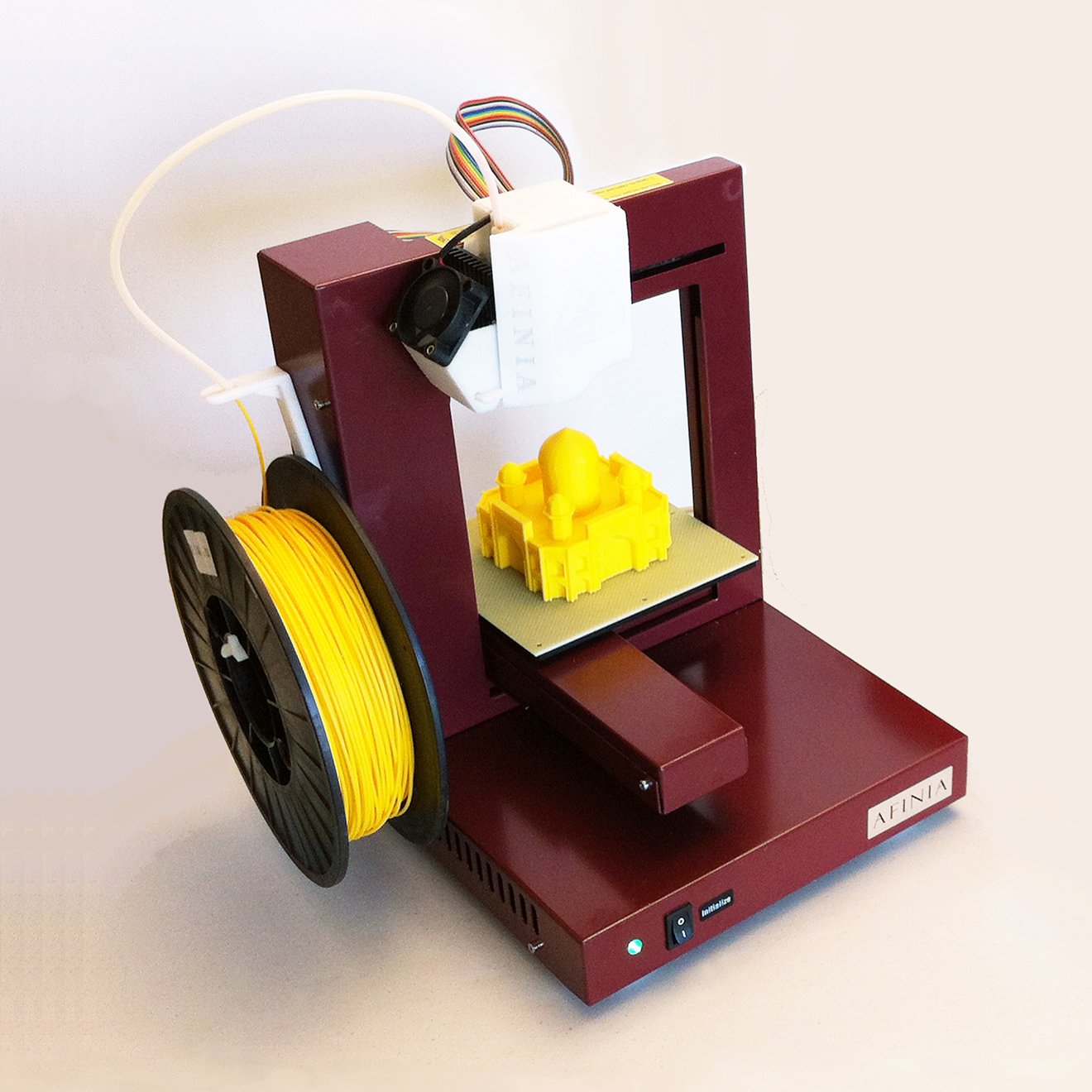When I decided I simply had to get a 3d printer of my very own, my first instinct was to get a Makerbot. They are probably the most widely publicized and hence best known consumer grade 3d printer available and you can simply stroll down to their NoHo store and walk out with one under your arm (well, figuratively anyway). They are reportedly very easy to use thanks to being preassembled and calibrated and coming with some easy to use software. There’s a lot to like here.
After reading the Make: Ultimate 3D Printing Guide, I started leaning towards the Afinia H-Series. It prints both PLA and ABS (the Makerbot Replicator 2 – the only model available at the time – only prints PLA) , is less expensive and won the Overall Best Experience prize out of the 15 different printers they looked at. Afinia is apparently a US branded version of the UP 3d printer from pp3dp which also apparently has US distribution. Confusing.
A couple other printers kept catching my attention and as I started digging around online seemed worthy of serious consideration: Ultimaker and printrbot.
There are a lot of folks out there making incredible prints with the Ultimaker. It has a very large print volume, prints with PLA or ABS (and folks have had success with a variety of other plastics as well), has a lot of community support and some great software integration. The support by nettfabb Engine is particularly appealing (Makerbot also supported).
The thing is, I live in a tiny Manhattan apartment and my little office/workshop/storage closet already has two watchmaking benches and a lathe/milling machine. I’m not sure I can commit space to keeping a 3d printer set up all the time, especially one with the footprint of the Ultimaker (you didn’t think that large build volume was free did you?). So I started to look long and hard at the printrbot jr.
The printrbot jr is available for $400 as a kit or $499 fully assembled. It prints PLA out of the box but is easily upgradeable (with the purchase of a heated print bed) to accommodate ABS. Best yet for my needs, you can remove the print bed and put the whole thing in a backpack.
There’s a lot to like about the printrbot company too. Brook Drumm started the company with a $25,000 Kickstarter that raised over $830,000, forcing him to scale up his dreams radically all of a sudden. Brook is a former youth pastor who brings the same passion for getting kids involved to his new company. Caleb Cotter (age 16) works side by side with Brook and the printrbot team on weekends and contributed to the design of the printrbot Plus/LC fan mount among other things and their new iPhone app MAKRZ was designed and built by a 17 year old. Brook’s serendipitous partnership with Carl Ubis resulted in printrbot’s Ubis hot-end,, one that Brook believes is perhaps the best in the industry. Carl spent 31 years working for HP, including running a failure analysis lab, so he brings a level of real-world product development experience seldom seen in other 3d printing startups.
While the jr made perfect sense for me in a lot of ways, I began to find myself looking longingly as the ambitious printrbot GO. Designed in collaboration with Ben “Heck” Heckendorn, the man synonymous with clever portability mods of electronics (seriously, check out his blog), the printrbot GO is designed to fold up into a suitcase.
The interlocking birch panels with their laser cut edges, here and there punctuated with a switch or an electrical connection, give it a decidedly “What the hell is he building in there?” aesthetic that I started to fall in love with. Being able to fold it up and stick it in a closet is perfect for my apartment and I’m starting to fantasize about taking it with me when I go visit my nieces. Can one arrange special meetings with JFK TSA to pre-screen a device to put in an overhead compartment?
It prints in PLA or with ABS with the addition of a heated printbed and has a fairly large print volume of 200mm x 185mm x 150mm (approx. 7 3/4″ x 7 1/4″ x 6″) and mostly shares hardware and electronics with the printrbot LC and Plus otherwise (as far as I can tell).
It’s much more expensive than the other printrbot offerings, only comes as what must be a fantastically complicated kit (NOT preassembled). Better yet, I will reportedly be only the 4th person to own one (Brook, Ben, some other guy/gal and me?), but David@printrbot has assured me they’ll do their best to have a complete set of instructions for me when it ships (any day now by the way). Perfect.








Hey there, wanted to link you to an article I saw online that I knew you’d be interested in.
http://www.washingtonpost.com/local/weapons-made-with-3-d-printers-could-test-gun-control-efforts/2013/02/18/9ad8b45e-779b-11e2-95e4-6148e45d7adb_story.html?wprss&google_editors_picks=true
I have enjoyed seeing your new blog taking shape, though I am beginning to wonder if there are people around you planning some sort of intervention and subsequent twelve step program for you. Being a bit obsessive in my own interests, I get it, but it is still interesting to see it from the outside in someone else. Just sayin’.
Thanks Janet! The gun control problem vis-à-vis 3d printing is unknown territory to an extent. On the other hand though, folks have always been able to build illegal stuff in their basement, so perhaps this just makes it easier/more-feasible? Is it illegal to download plans for a bomb?